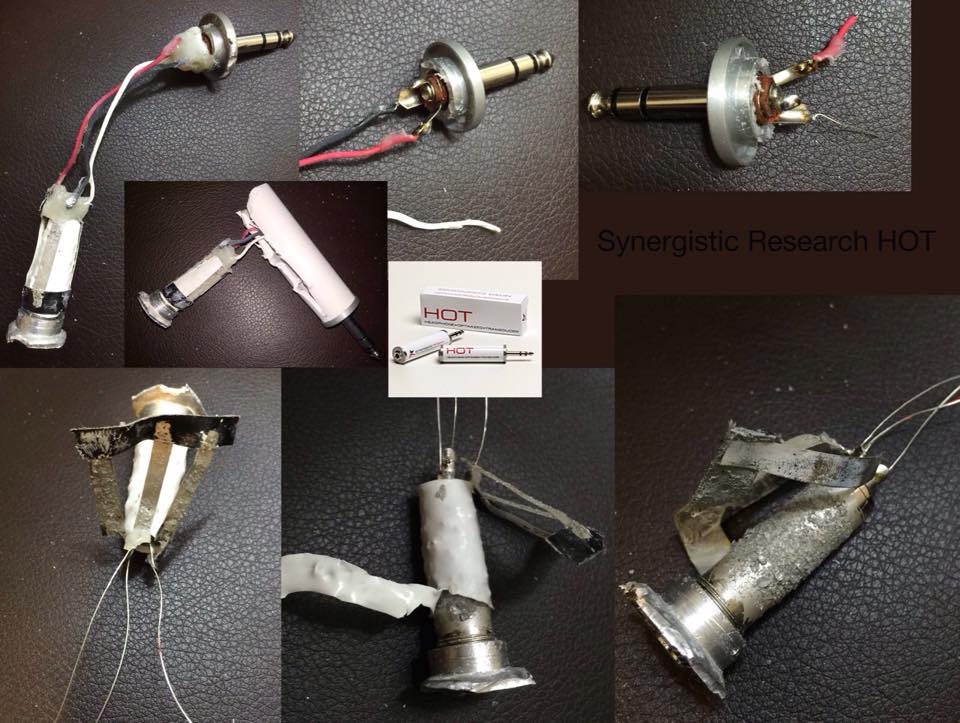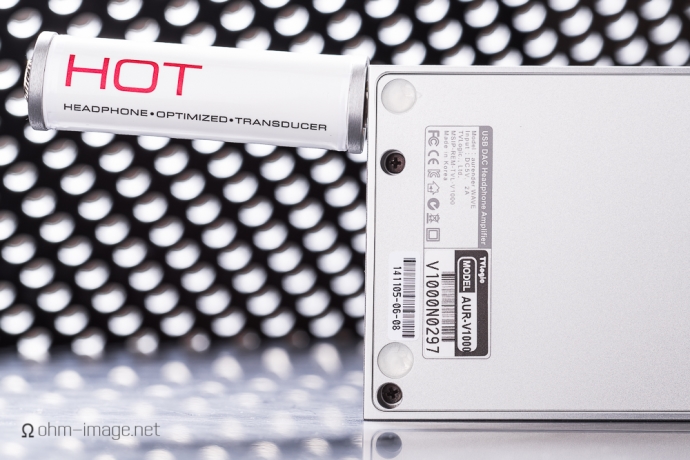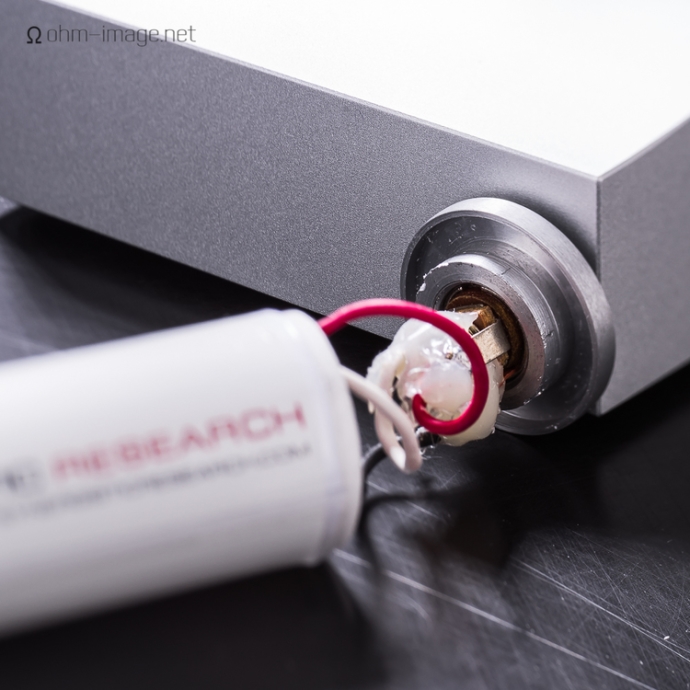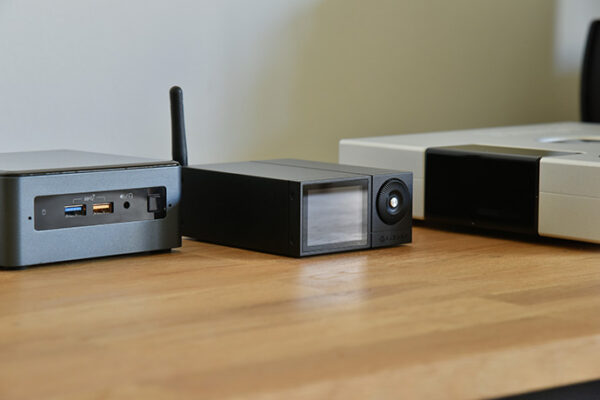Disclaimer: The Synergistic Research Carbon HT was given to me as a gift by Colab, a Belgian High-End Audio and Home Cinema shop. Pictures are courtesy of Ohm Image and Synergistic Research except for the one with the Headfonia logo. In case Innerfidelity and/or Ohm Image want me to remove the text copied from their sites, I will do so immediately.
Synergistic Research & the HT Carbon
Synergistic Research is a high end audio company that is mainly known for its cable development and power conditioners. On their website it says:
“At Synergistic Research we focus on a total system approach to create synergy in your system. All aspects of performance are taken into account and because there is more to synergy than just cables, we’ve developed some of the world’s most innovative solutions like our PowerCell line conditioners and Acoustic ART room treatments and MiG resonance control footers. Of course audio cable and power cords are one of the biggest contributors to system performance second only to room acoustics so we pioneered several ground breaking technologies like Active Shielding with air dielectrics and custom tunable cables with UEF Tuning Circuits to get you closer to the music than ever before.”
The HT Carbon is the successor to the controversial Synergistic Research HOT and it basically is a Headphone Transducer that is supposed to clear up sound and make your headphone sound better. I received it a week or 2 ago as a gift (it is supposed to be the first in Europe but there’s no way to verify that) and then I forgot about it for a few days. When I spotted it again (it’s fairly huge) I decided to give the filter a go. Don’t see this article as a review, it’s more about the HT Carbon itself and what has been happening online.
Synergistic Research describes it as following:
“The new and improved HT Carbon, Headphone Transducer, dramatically reduces the noise floor of your headphones compared to the previous HOT. The new Carbon fiber enclosure and a second generation headphone UEF filter has truly elevated the performance of the HT Carbon. Other improvements like modifying the plug on the HT Carbon, now allows for easy use on Headphone amps with recessed headphone-out connections. Simply Amazing.”
On Head-fi two different threads were created a long time ago to discuss the HOT and a now banned user called “Bigshot” even took it apart (Glue – Sand – Tape. See pic, Copyright of the original poster on Head-fi). The HOT was and still is a very controversial product, SR’s boss even joined the conversation but in the end both threads just had to be locked as discussions got “heated” to say the least. You can find the threads here and here.

Nathan, my partner in crime from Ohm Image, also wrote about the HOT on his Ohm Image website a few months ago. His HOT was leaning a bit to the left and he accidentally broke open the HOT when plugging it out of his Aurender Flow.

He wrote:
“Anyways, I got to see inside. Inside are wires, glue, and glue and glue and more stuff, including some dead space. I like glue. I love the smell of the inside of the HOT. I went at it like Billy Pilgrim on a vat of syrup.
I came to the following Tuesday. The last 30 minutes of battery in my RWAK100 fizzled over a bit of Ultraviolence. And damn, Lana sounds good, too. It was totally like I was tripping. Like magic. Like nothing possible short of a glue high and the whiff of famous vagina.
Sean asked me to give a real report. Something, maybe the glue, maybe the fact that I’m not yet dead, makes me think I’ll have to revisit this.”
For more photographs, head to: Ohm Image – Synergistic Research’s Headphone・Optimised・Transducer tastes like Pepsi Cola
Click HERE or below to go to the next page

Click HERE or below to go to the next page










spudgered
I had the original version of this device and it actually made my headphones sound worse! It added a muddy smear to the music which attenuated frequency extremes and was very unpleasant to listen to. I took the HOT to a mini-meet and 90% of listeners thought it was detrimental to their headphone listening. Unsurprisingly a tube packed with sand and a wire with a bit of tin foil in it ain’t conducive to aural pleasure nor your wallet! AVOID AS THIS IS PURE SNAKE OIL.
dalethorn
Another good look at an odd product – thanks. Seems obvious from your review that it is a filter and so some data is removed by the filtering. Probably not good. I remember when I began my adventure with some bright headphones, among which was the Shure 1440. My simple mods for filtering highs involved stuffing the earcups. What I learned was that the material used for that purpose makes all the difference, i.e. you’re likely to get best results by using what Beyer, Sennheiser, and other mfrs. use. At $350, this HT filter should be using the best materials known to hi-fi science.
Headfonia_L.
Thanks Dale! It’s a “special” unit, that’s for sure. But like with everything, I’m sure some people will like what it does. That being said, I’d be more inclined to say those who do aren’t listening to the right headphone for their taste. Like maybe a T90 in combination of someone who likes thick dark mids and hates treble.
dalethorn
Yeah – if headphone A sounds a bit ragged and the filter makes it seem smoother, happy customer. For awhile at least.
ohm image
Dale’s famous Shure 1440. Oh, we remember that!
dalethorn
That’s actually a decent headphone. Bright, but addressable with the acoustic pads. Decent bass (unlike the Shure 1840). Now at bargain prices.
ohm image
I believe you. I’ve not picked one up specifically for comfort reasons. That said, I am getting a Myst IzoPhones, which is about as clampy as they get.
dalethorn
If you’re willing to pay shipping, I’ll send you my Flare Audio R1 at no cost. Then you will experience something akin to the Iron Maiden (and not the music group of that name).
SquidCap
Measure it ffs. If a person review gear, he maybe should invest in the tools he needs to make any kind of valid testing. No need to fucking guess, second hand oscilloscope, one 80 buck ADC and a UMIK should at least be in the inventory. Amateurs..
In this case, i’ll bet we find: lopass/high-shelf, -2dB starting from 12k, presence peak between 3k-8k around 3dB. Then you measure it with multimeter and reverse engineer the filter.. It is not rocket science.
Headfonia_L.
Dear Sir, be open minded, not everything is about measurements. I’ll take my ears anytime over numbers. Not saying numbers aren’t important but if it sounds good, I really don’t give a heck about measurements.
dalethorn
Our problem is that measurements are good tools for manufacturing and quality control, but they don’t model the listening experience very well. Someday maybe there will be a breakthrough.
Joseph Quattrochi
Props to you for giving this product an honest try. As an aside, I can’t help but notice a sentence that stands out to me as..a bit strange.
“The first thing I noticed with the HT connected to the HD800 was how it gave a feeling of added “air” as its sound got more spacious in a Nighthawk kind of way.”
In what universe does adding more air and spaciousness to the HD800 make it more similar the Audioquest Nighthawk?
Headfonia_L.
it means: in an artificial, unnatural and blooming way 🙂
Larry
Thank you for your honest review. This confirmed my suspicion that as an active device, it may make less musically accurate and revealing headphones sound better — a Band-Aid of sorts. But with higher-end gear, I prefer more passive tweaks (i.e. Synergistic’s HFT devices for room acoustics).
Speaking of passive devices, has anyone at Headfonia reviewed the Bybee QSE? I’ve heard them in high-end home audio systems and they’re magical — the vocals and instruments become more 3-dimensional, I feel a deeper emotional connection to the music, and the soundstage is enhanced. I’m planning on buying a Woo Audio Eclipse along with a couple QSEs to improve the sound even further.
dale thorn
For me, a $350 tweak has to be pretty much non-controversial. Controversy is OK for a $50 tweak, maybe even $100 if it has great promise, but for $350 as a mere tweak, it had better be an unambiguous improvement.